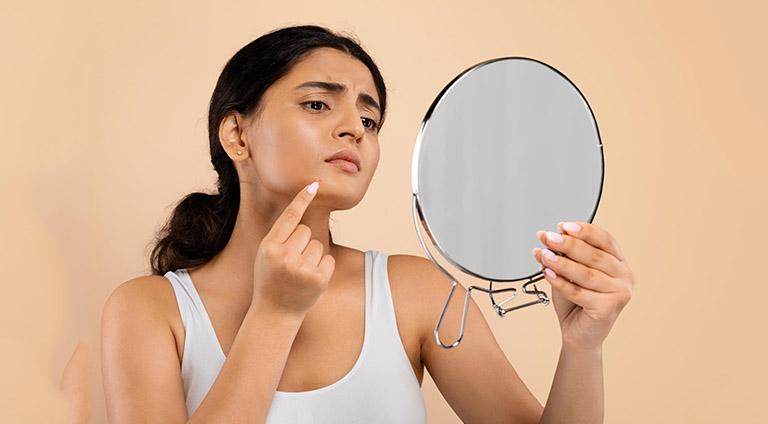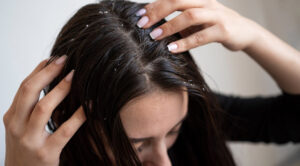The Bare-Faced Method
- Wash your face with a gentle cleanser to remove any makeup, dirt, or oils.
- Pat your face dry with a soft towel and leave your skin bare—no moisturizers, toners, or serums.
- After about an hour, examine your skin in a well-lit mirror.
- Observe how your skin feels and looks:
- Normal Skin: Your skin feels comfortable—not too oily or too dry. It has a balanced texture, with small, barely visible pores.
- Oily Skin: Your skin appears shiny, especially on your forehead, nose, and chin (the T-zone). Pores may appear enlarged, and you might notice some blackheads.
- Dry Skin: Your skin feels tight and may look flaky or rough. Fine lines might be more noticeable, and your pores are likely small and less visible.
- Combination Skin: You have a mix of oily and dry areas, usually with an oily T-zone and dry cheeks.
- Sensitive Skin: Your skin may feel itchy or appear red and irritated, especially after using certain products or being exposed to extreme weather.
The Blotting Sheet Test
- Here’s how to do it:
- Gently press a blotting sheet against different areas of your face, such as your forehead, nose, chin, and cheeks.
- Hold the sheet up to the light to see how much oil it absorbed.
- What to look for:
- Normal Skin: Minimal oil is absorbed, with no significant oiliness in any area.
- Oily Skin: The blotting sheet picks up a noticeable amount of oil from all areas of your face.
- Dry Skin: The blotting sheet shows little to no oil.
- Combination Skin: The blotting sheet absorbs oil primarily from the T-zone, while other areas remain dry.
- Sensitive Skin: You may not see much oil, but your skin might feel irritated after using the blotting sheet.
Pay Attention to Your Skin’s Behavior
- Consider the following:
- Normal Skin: You rarely experience breakouts or irritation. Your skin feels well-balanced, regardless of the products you use or the climate.
- Oily Skin: Your skin tends to get shiny or greasy by midday, even if you used mattifying products in the morning. You might also struggle with frequent breakouts.
- Dry Skin: Your skin feels tight and uncomfortable, especially after washing. You might notice flaky patches or an overall dull appearance.
- Combination Skin: Your skin changes depending on the season or environment—dry in the winter, oily in the summer. You might have to use different products on different areas of your face.
- Sensitive Skin: Your skin reacts easily to new products, with redness, itching, or burning sensations. Environmental factors like wind or pollution may also trigger irritation.
Consult with a Professional
While these DIY methods are helpful, nothing beats a professional consultation. As a top cosmetologist in Pune, I recommend visiting a skincare expert for a thorough analysis. We At Shree Sai Clinic can provide you with personalized advice and recommend products tailored to your unique skin type.
Understanding your skin type is the foundation of an effective skincare routine. By using these simple tips, you can take better care of your skin and choose the products that will keep it healthy, radiant, and resilient. Remember, your skin type can change over time due to factors like age, climate, and lifestyle, so it’s important to reassess your skin’s needs regularly.
Taking the time to understand your skin will pay off in the long run, leading to a more effective and satisfying skincare routine.




